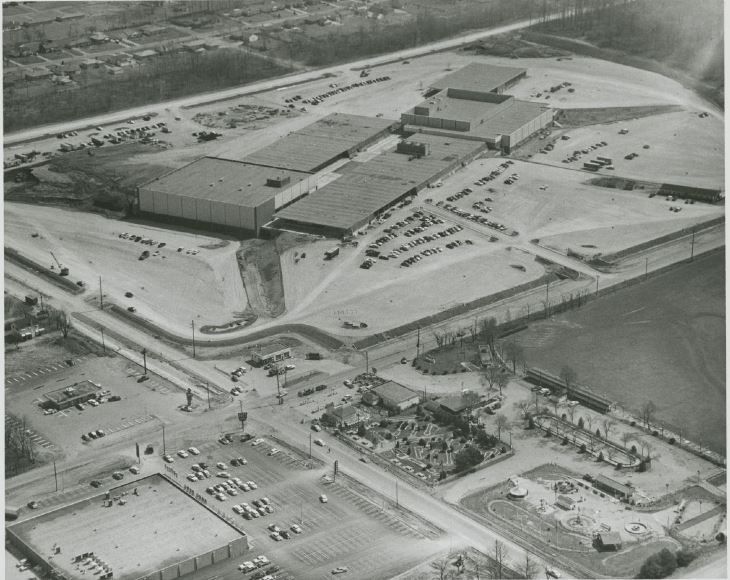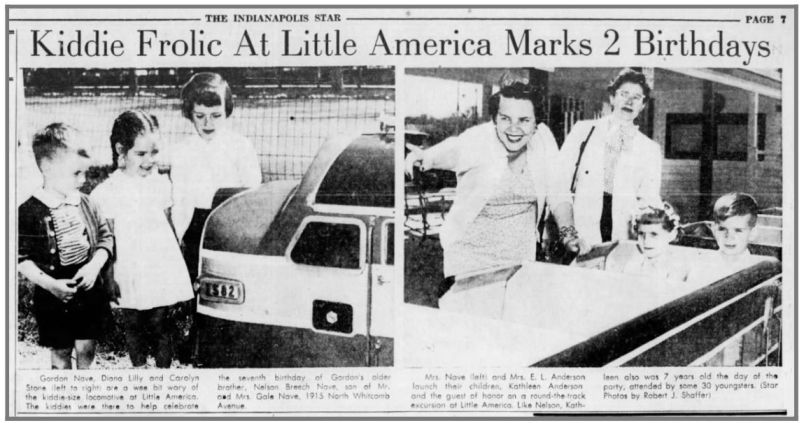
|
Harley H. Hornbeck opened the Little America Amusement Park in Indianapolis at 62nd and Keystone in 1930 as a “Tom Thumb” golf course.1 The first amusements included golf, bowling, shuffleboard, badminton, ping pong, horseshoes, archery, and tennis, all on 18 acres. The park billed itself as “Healthful Recreation for All of the Family.”2 By 1941 the park had grown in popularity and was selected by Life Magazine for a photo essay by Wallace Kirkland.3
In 1943 Harley Hornbeck leased Little America to C. E. Foreman, an Indianapolis businessman. The park was managed by William S. Burrows who was assisted by Robert M. Jones.4 Eating stands were added and with its extensive outside lighting system, the park was able to remain open until midnight. It enjoyed great success in the summer months, the main attraction being that it offered many different forms of outdoor activities all on the same grounds.
By 1945, Hornbeck was ready to sell. Little America was purchased by a group of Indianapolis businessmen headed by sportsman John Ensley.1 The new owners began making extensive plans for the development of additional amusements. By 1950, a pony track with live ponies had been added as well as a kiddie playground area.5 In 1953, the aging park’s restaurant was renovated and modernized and a roof garden was added.6

|
Another change was that the children’s area of the park, affectionately called “Kiddie Land,” had new operators, Mannie Marcus and Marc Wolf.6 Both Marcus and Wolf were well-known theater operators in the Indianapolis area. They leased the restaurant and the 3-acre children’s section of the park from owner Jack Ensley. They renamed Kiddie Land “Wonderland” and added $75,000 of upgrades which included eight rides.
The new featured ride at Wonderland was a $20,000 train with double header locomotives. Based on GM diesel streamliners, the locomotives pulled three coaches and an observation car over a half-mile of track. The route included two crossing signals and a tunnel.7

|
Another new ride was the kiddie fire wagon. The fire wagon was built of all steel construction from a jeep chassis and had hoses, sirens, bells, and lights. It took children on mock “fire calls” throughout the amusement park. Also new was an Allan Herschell merry-go-round, boat ride, sky fighter, auto ride, Little Dipper roller coaster, and a western corral featuring ponies imported from Nebraska. The ride attendants wore new white uniforms and numerous safety devices were put in place.7

|
The “Wonderland” section of Little America was wildly successful. It had become one of the new micro amusement parks for children that were being promoted by the Allan Herschell Company in the early to middle 1950’s. By 1955, the Wonderland name had largely been dropped and the children’s amusement area was once again referred to as “Kiddyland,” this time spelled with a “y.”

|
In May of 1955, the Glendale neighborhood which included Little America was annexed into the city of Indianapolis.8 This would bring about a number of problems for the micro park, problems which first began two years later in 1957. A disagreement over the proposed erection of a new train ride in Broad Ripple Park, seven blocks to the east of Little America, ended up in superior court. Glendale homeowners along with the operators of Little America sued to prevent the construction of the ride.9
The disagreement arose when Baron Paul, a Broad Ripple Park concessionaire, proposed to build railroad tracks for a miniature train ride around the big steam locomotive donated to the park two years earlier. The steam locomotive, nickel plate # 587, was put on display there and was accessible to all who wished to climb up into it.*
The homeowners and operators of Little America were concerned that if the miniature train ride were built, Broad Ripple Park might once again be turned back into an amusement park (Indianapolis’ White City Amusement Park burned to the ground on that very site in 1908). The homeowners argued that they did not want another amusement park in their neighborhood. For the operators of Little America, it was a matter of not wanting competition. In the end, the homeowners and operators of Little America won their lawsuit and the miniature railroad wasn’t built.
One positive note in 1957 was that Little America became the site of one of the first Burger Chef restaurants in America. Frank Thomas began grilling his famous hamburgers and selling them at a stand within the park. They were very popular and business for Thomas was excellent as Little America continued to draw in record summer crowds.
In September of 1958, Ensley was back in court, this time fighting the city over a right-of-way. Ensley claimed that the city sought to deprive Little America of 654 feet of business frontage worth $300,000.10 The city wanted the land to widen Keystone Avenue. The jury decided in Ensley’s favor but the damage award was only $127,733 which was less than half of what he was asking.11 The state appealed the jury’s verdict and the case went to the Indiana Supreme Court.
April of 1959 brought disappointing news. The Supreme Court of Indiana made permanent an order preventing the Marion Circuit Court from paying Ensley the damages he’d previously been awarded and would not honor his request to return the land the city had taken from him.12 Ensley continued to battle with the city for most of the year. Finally in March of 1960, he announced that Little America would continue to operate that year but on a smaller scale and that it was for sale.13
In the meantime, Marcus and Wolf continued to lease and operate Kiddy Land at Little America which had not been effected by the land dispute. Ensley purchased a 9-acre site at 56th Street and Guion Road where he made plans to relocate his amusement park and rides.14 Neighbors in the area protested, but approval was given by the Metropolitan Planning Commission because the site wasn’t “really near” anyone’s home.
Little America and Kiddy Land opened on schedule at the 62nd Street and Keystone location in April of 1961. Little America was advertised as being “under new management” but still offered golf, go-carts, trampolines, archery, baseball, and other amusements.15 The drive-in restaurant was also open. Ensley had not sold Little America but had leased it out and it continued to operate. A few blocks down the road at 56th and Guion, Ensley invested most of his efforts into his new golfing center and driving range.
In 1962, the drive-in restaurant at Little America closed and efforts to lease it were fruitless.15 By 1963, Little America was once again at odds with the city which wanted to close Hillside Street from 61st Street to 61st Place. This area encompassed a short section of the southwest corner of the park.16 Ensley had had enough and closed the amusement center. On June 10, 1963, Marc Wolf, one of the operators of Kiddy Land, passed away.17 By 1964, all of the Little America facilities had been removed and a new golf center was built by a new tenant, Wayne Timberman Jr., at a cost of $50,000.18,19
An advertisement for Kiddie Land – Little America appeared in the Indianapolis Star in 1964. It gave the new location of the park as being at the Eagledale Shopping Center, behind Sears just off of Lafayette Road on the northwest side of town.20 In October, there was a fire there in one of the ticket booths shortly before the park was to close for the season.21 The park did not open for the 1965 season.
In May of 1965 an advertisement for the sale of children’s rides and amusements appeared in the Indianapolis Star. The ad specified the location as “out on the west side in a suburb.”22 It is highly probable that these were the Kiddy Land – Little America rides since Eagledale is located on the west side of Indianapolis. In retrospect, the relocation of Kiddy Land to within two miles of its largest competitor, Riverside Amusement Park, probably wasn’t a prudent business decision.
*Nickel plate # 587 remained in Broad Ripple Park until 1983 when it was sent to Forest Park in Noblesville, Indiana, for restoration. It is presently at the Indiana Transportation Museum.
References Cited: